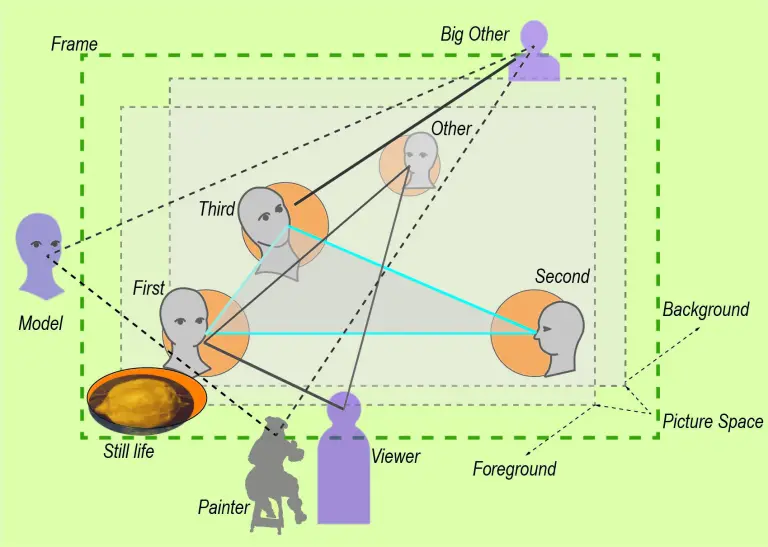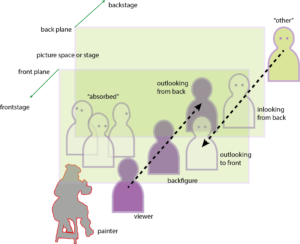In this post, we take a closer look at gazes and faces in Velasquez’ painting.
But first, I like to make a comment:
In the previous posts, I have managed to take a critical position regarding at least four prominent experts on Manet – Fried, Locke, Wollheim, and Greenberg.
That sounds overly ambitious, and I like to clarify my aims again.
I am no expert. MyManet can be understood in different ways:
- MyManet is my personal view which sometimes does not correspond to views of others (experts or not).
I keep learning by reading and re-reading the contribution by others, including those cited above.
I will change my views as we go along. MyManet is just reflecting the state of my journey.
It is fun, but it is still an open adventure. - MyManet does propose a way of “reading” Manet – the puppet theatre model – which may turn out to be more than a personal exploration. But this is up to discussion – with Your Manet.
- MyManet is an inspiration for my own projects of painting. Whether it is productive, I have to explore by painting – there is no other way.
I will document this in My Gallery.
So, I will report my sources as we travel along, and sometimes I will be inspired and sometimes I will disagree.
But I will always be very selective, not trying to do justice to the rich content of my sources.
Now, let us take the next step in our journey.
I have to explain more about gazes and social space, and we will first have a closer look at the figures and space inside the painting.
Manet was fascinated by the paintings of Diego Velazquez (1599-1660).
(A rich source on Velazquez and Manet is Tinterow & Lacambre 2003).
The Spaniard was, in Manet’s view, the greatest painter, and he copied his works and borrowed themes for his own paintings.
So, we have a look at three of Velazquez’ paintings.
We focus on the gazes of figures within the painting, and I suggest reducing them to diagrams with their faces.
(The idea of the diagrams I owe to Todd Oakley 2009)
The case of Manet’s copy (1859) of Velazquez Conversing Gentlemen is shown in Figure 1:
Figure 1: The Little Cavaliers – Manet’s copy (1859)
of Velazquez’ Conversing Gentlemen
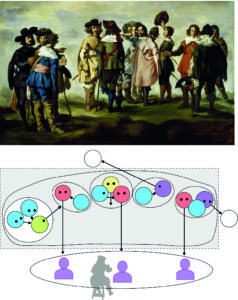
What must have intrigued Manet, is the variety of gazes. The gentlemen look outward to the viewer or viewers (red) or at each other (blue) forming little subgroups. There is a group in the foreground to the left and one person (green) is looking over to the group in the middle ground. At least two gentlemen (purple) appear to be looking outside the painting to “unrepresented” persons (white), but not to the viewer. We might see them also as looking onto persons accidentally out of the painting’s frame (in which case, they should be coloured green; see below). One person in the middle (yellow) appears to be rather unfocused (or “absorbed”).
We should also note that there is no background, and the scene might as well be on a stage. The scene is “theatrical”, to be sure, and rather distant from viewer and painter. But the group to the left does not play the role of a backfigure asking the viewer to identify and drawing the viewer in. Rather, the picture space is divided into social spaces, the space to the right being closer and kind of marking the “frontstage”.
So, we take another example “zooming in” to a more optimal scale of communication.
Figure 2: The Drinkers or The Triumph of Bacchus (Velazquez 1629)
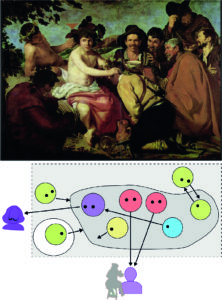
The Drinkers (or The Triumph of Bacchus) are obviously having a good time and are intensively communicating with each other (blue) and with the viewer/painter (red). (Manet must have liked the painting, since he reproduced it within his portrait of Emile Zola.)
Again, we have a figure in the foreground (green) looking onto the group. In this case, there are also two figures (green) looking from the side or even from the back (green) onto the central group. On of the group (green) on the right is exchanging the gaze (green) with the figure in the back. In the centre, we find one person clearly “absorbed” in the ceremony (if not drunk).
A special case is the figure in the centre (purple) looking outward to the front, but not to the viewer/painter. He is a somewhat mystical figure (Bacchus) and his gaze is intensively connecting to someone important outside.
He clearly is not looking accidentally out of the frame. The figure outside is not an “unrepresented” viewer in the usual sense, since we feel that the figure is outside in a more fundamental way. The figure, it seems, would not be appearing within the painting, if only the viewer would retreat a few steps (“zooming out”).
For lack of a clear identification of this external agent – at this point – I have assigned to it an icon for the Master Velazquez himself, placing Manet, as his greatest fan, in the position of the painter.
Finally, there is no way to discuss Velazquez and Manet without having a look at Las Meninas – here only a detail with the group of people (there is a vast space toward the ceiling in the upper part showing how Velasquez puts the scene on a “royal stage”). Now, this painting is perhaps the most complex depiction of the process of painting and the role of gazes in the history of art, according to most experts. So, we do not want to be too ambitious, we reduce the masterpiece to our little diagram (we will return to it, no doubt, since it is central for the interpretation of Manet’s work).
Figure 3: Las Meninas (detail) (Velazquez 1656)
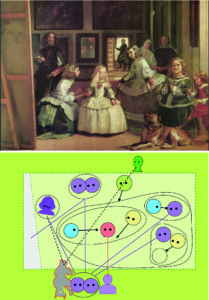
Let us focus on a few interesting elements. A first impression for most viewers is probably that the girl in the centre (red) – Infanta Margerita, the royal daughter – is looking at them, the viewer. The maid (blue) is looking at her, enforcing the viewers tendency to look at the girl.
But then it gets complicated.
Looking to the left, the viewer sees the Master Velazquez himself towering over the scene, and the viewer starts wondering if the Master is looking at the viewer – or rather at the “unrepresented” person entering the scene and obviously making everybody pause in their activities. The viewer, then, may discover (although everybody looking at the painting in the Prado in Madrid already knows) that the royal couple is entering the scene as shown in the mirror on the opposite wall.
In our diagram, this event creates a lot of gazes directed outward to the royalties or somewhat unfocused.
Actually, the royalties appear to be the only persons to gaze (through the mirror) onto the painting – the viewer is left to guess what is on the painting (as are generations of art historians). The royal couple may be as well the model being painted, since the daughter is, at the moment, not posing for Velazquez. The Master may – moreover- winking at his colleagues, painters looking at his (activity of) painting…
For our purposes, we don’t even aspire to solve all the mysteries and games Velazquez has been hiding in the painting. We just observe that the painting is highly “theatrical” engaging the viewer, creating a social space reaching outside the painting, and, in fact, creating a rather crowded situation in front of the painting.
However, by placing himself into the picture, he is not supporting the imagery of a “stage” in front of an audience. We find us all in that large hall without a specific figure – represented or unrepresented – to identify with.
What is not so obvious, perhaps, are the subtle ways that Velazquez not only draws the viewer into the scene, but also induces effects of distancing. Part of these effects is due to the diverting gazes of some of the figures, and to the interruption of their interaction putting them “on hold”.
We have seen this effect already in Luncheon on the Grass.
Part of it may be, because we as viewers feel somewhat uneasy being crowded there next to the royalties.
The interpretations are endless.
Of special interest for us – for MyManet – is the figure in the back looking from the back onto the scene.
From the point of view of the puppet theatre, he is about to leave the “stage through the coulisse”, and, therefore, he is the paradigm case for the “Other” as represented within the painting. The figure is having his own rather independent view on the scene from “behind” – much like the second woman in Luncheon on the Grass!
Again, as in the case of Bacchus in The Drinkers, we feel that there is more to the figure than looking onto the scene (or toward an external agent as in The Drinkers). The painter Velazquez in front of the painting seems to communicate with himself within the painting and with an external “Other” (or alter ego) ”behind” the painting.
Manet must have been fascinated by the games the Master is playing!
Manet saw the original – rather than prints – only after he painted his Luncheon on the Grass on his trip to Madrid in 1865, but he must have felt confirmed in his own approach to the “painting of painting”.
The study of gazes in Velazquez’ paintings has furnished us with a range of different figures in diagrams, not all of them appeared in all three examples and some appeared more than once.
The next step has to be to characterize the figures and their function in more detail.
Then, we will be able to ask the obvious next question, namely, which figures or how many are necessary in a “painting of painting”?
See you next week!
